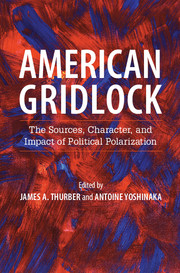Book contents
- Frontmatter
- Dedication
- Contents
- List of contributors
- Foreword
- Acknowledgments
- Introduction
- PART I POLARIZATION AMONG VOTERS AND ACTIVISTS
- 1 The New American Electorate: Partisan, Sorted, and Polarized
- 2 Redistricting and Polarization
- 3 Party Activists, Interest Groups, and Polarization in American Politics
- 4 Authoritarianism and Polarization in American Politics, Still?
- 5 Party Sorting: The Foundations of Polarized Politics
- PART II POLARIZATION IN NATIONAL INSTITUTIONS
- PART III POLARIZATION IN THE STATES
- PART IV POLARIZATION IN THE MEDIA
- PART V IMPLICATIONS AND CONCLUSIONS
- Index
- References
1 - The New American Electorate: Partisan, Sorted, and Polarized
from PART I - POLARIZATION AMONG VOTERS AND ACTIVISTS
Published online by Cambridge University Press: 05 November 2015
- Frontmatter
- Dedication
- Contents
- List of contributors
- Foreword
- Acknowledgments
- Introduction
- PART I POLARIZATION AMONG VOTERS AND ACTIVISTS
- 1 The New American Electorate: Partisan, Sorted, and Polarized
- 2 Redistricting and Polarization
- 3 Party Activists, Interest Groups, and Polarization in American Politics
- 4 Authoritarianism and Polarization in American Politics, Still?
- 5 Party Sorting: The Foundations of Polarized Politics
- PART II POLARIZATION IN NATIONAL INSTITUTIONS
- PART III POLARIZATION IN THE STATES
- PART IV POLARIZATION IN THE MEDIA
- PART V IMPLICATIONS AND CONCLUSIONS
- Index
- References
Summary
• The United States has entered a new era of electoral competition in the twenty-first century.
• The key features of the new era of electoral competition are a closely divided electorate at the national level, one-party domination of most states and congressional districts, and a high degree of consistency in the outcomes of elections over time and across different types of elections.
• These features of electoral competition reflect the growing strength of partisanship within the American electorate – party loyalty and straight-ticket voting have reached record levels in recent years.
• The partisan behavior of the electorate is based on a growing divergence between the Democratic and Republican electoral coalitions along racial, cultural, and ideological lines.
In the first two decades of the twenty-first century, the United States has entered a new era of electoral competition. This new era of competition has three main characteristics that distinguish it from the patterns of electoral competition that were evident for half a century following the end of World War II. First, there is a close balance of support for the two major political parties at the national level, which has resulted in intense competition for control of Congress and the White House. Second, despite the close balance of support between the parties at the national level, there is widespread one-party dominance at the state and local levels. Third, there is a high degree of consistency in the outcomes of elections over time and across different types of elections. These three characteristics are closely related. All of them reflect the central underlying reality of American electoral politics in the current era: an electorate that is strongly partisan and deeply divided along racial, ideological, and cultural lines (White 2003; Hood, Kidd, and Morris 2004; Abramowitz and Saunders 2006; Brewer and Stonecash 2007; Jacobson 2007; Hillygus and Shields 2008, ch. 5; Abramowitz 2013; Jacobson 2013).
COMPETITIVE ELECTIONS
Recent national elections in the United States have been highly competitive. Shifts in party control of both chambers of Congress and the White House have been fairly regular, and popular vote margins in presidential elections have been relatively close. Between 1948 and 1992, shifts in party control of the White House occurred quite regularly, with party control changing in 1952, 1960, 1968, 1976, 1980, and 1992.
- Type
- Chapter
- Information
- American GridlockThe Sources, Character, and Impact of Political Polarization, pp. 19 - 44Publisher: Cambridge University PressPrint publication year: 2015
References
- 12
- Cited by



